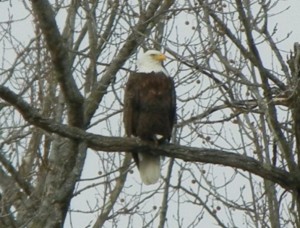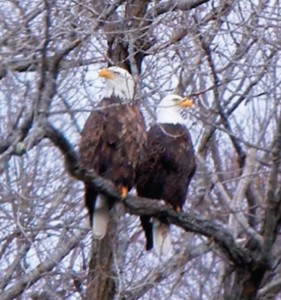For the past several years, the New York Department of Environmental Conservation has involved volunteers for a mid winter bald eagle survey. Visit their website (click here) to find more information. But first, enjoy the narrative below written by one of the January 2011 volunteers, 13 year old Thomas Kirby.
Mid-Winter Bald Eagle Survey
By Thomas Kirby
On the cold, cloudy morning of January 10th, Mary Batcheller, Mary Kirby, and I participated in the annual Mid-Winter Bald Eagle Survey coordinated by the New York State Department of Environmental Conservation in partnership with the U. S. Army Corps of Engineers. Each year, in early January, approximately 100 observers survey specific routes throughout New York State in search of these magnificent birds. In addition, the NYSDEC conducts aerial surveys.
This was my second year participating in the survey, and my first year as the data recorder. The task of our group was to search for bald eagles along the Hoosic River in Rensselaer and Washington counties. The purpose of the survey, which is part of a larger national survey, is to identify wintering sites of bald eagles and to track population trends. Our method was to drive along a specific route watching for eagles, and stopping at pullover points to scan with binoculars.

We saw an exceptional number of eagles this year – six adults and one juvenile. In the previous seven years that Mary Batcheller surveyed the same route, the total counts ranged from zero to two. Reflecting on the large number of sightings this year, she commented, “I really have no idea why there were so many! A gradual increase due to breeding success would seem more logical. But I’m thankful that the Hoosic River is supplying some great wintering habitat for bald eagles!”
We began at 8:40 a.m. at the point where the Hoosic River crosses from Massachusetts into New York. At 9:25, we spotted the first eagle perched in a tree near the river in the town of Hoosick, not far from the Hoosick Falls Central School. As we watched it flew off to the south along the river. I was really happy that we saw one so early on, knowing that we might have done the whole route without a single sighting. Little did I guess how much excitement was in store for us.
Just ten minutes later, in Hoosick Falls, we noticed a dark bird circling in the distance. It was a juvenile Bald Eagle. (They lack the distinctive white head and tail feathers of an adult.) We couldn’t believe that we’d already seen two, but number three was soon to come. Still in Hoosick Falls, I spotted a second adult as we crossed a bridge leading into the center of town. At the pullover point, we saw both the adult and a juvenile perched directly across the river from us. It may have been the same juvenile that we saw earlier, so we didn’t add it to the count. Just as we were climbing back into the car, another adult came flying in from the north! Four!
Around 11:00, we were stopped on Morris Road in Buskirk. As we scanned the landscape, we saw two adult Bald Eagles feeding on a carcass in the middle of a field. Thirty minutes later, in Valley Falls, we saw a single adult perched by the river, bringing the total count up to seven. At noon, we reached the end of our route and concluded the survey, amazed that we had seen so many eagles.

Along the way we also observed 24 other species of birds, including Common Merganser, Red-bellied Woodpecker, Rough-legged Hawk, Carolina Wren, and Common Raven. And as if that wasn’t enough, on the way back we saw another pair of adult Bald Eagles, in a tree near the Johnsonville Dam. They were sitting so close together that it looked like they touched. One of them took off, but not before I got a photo of the pair from directly across the river. Moments later the other one followed. Because of the possibility of counting the same birds twice, the survey is only conducted in one direction; so this was an “unofficial” sighting. But it was a great way to end an incredible morning of eagle watching!
Thomas Kirby is 13 years old and lives in Williamstown, MA.